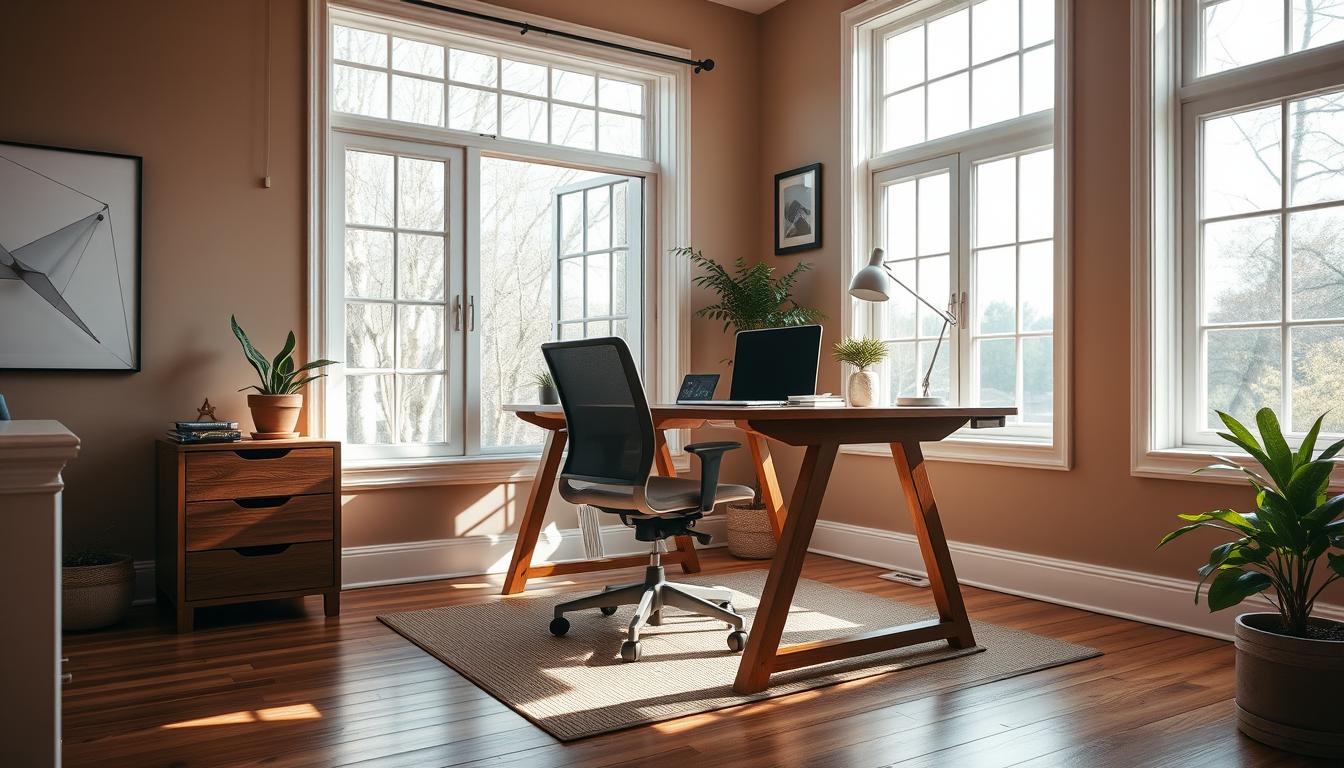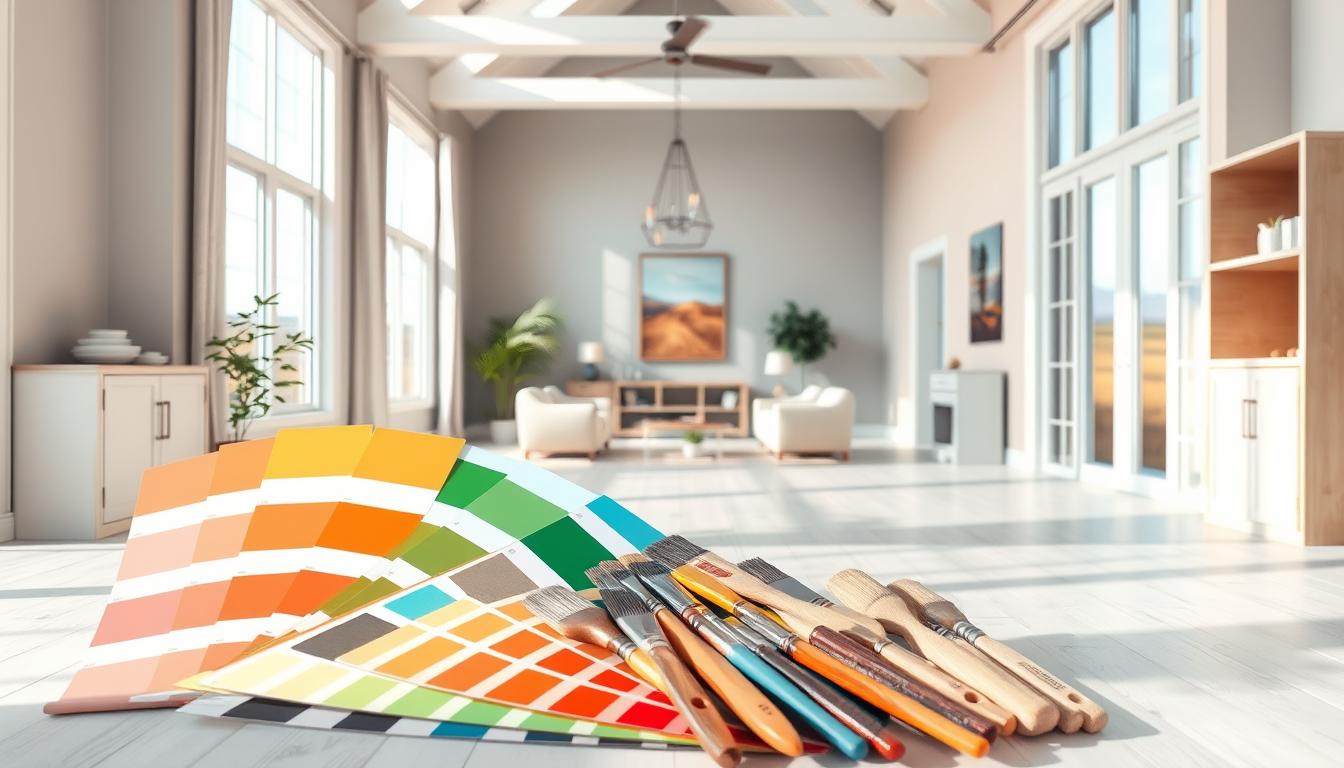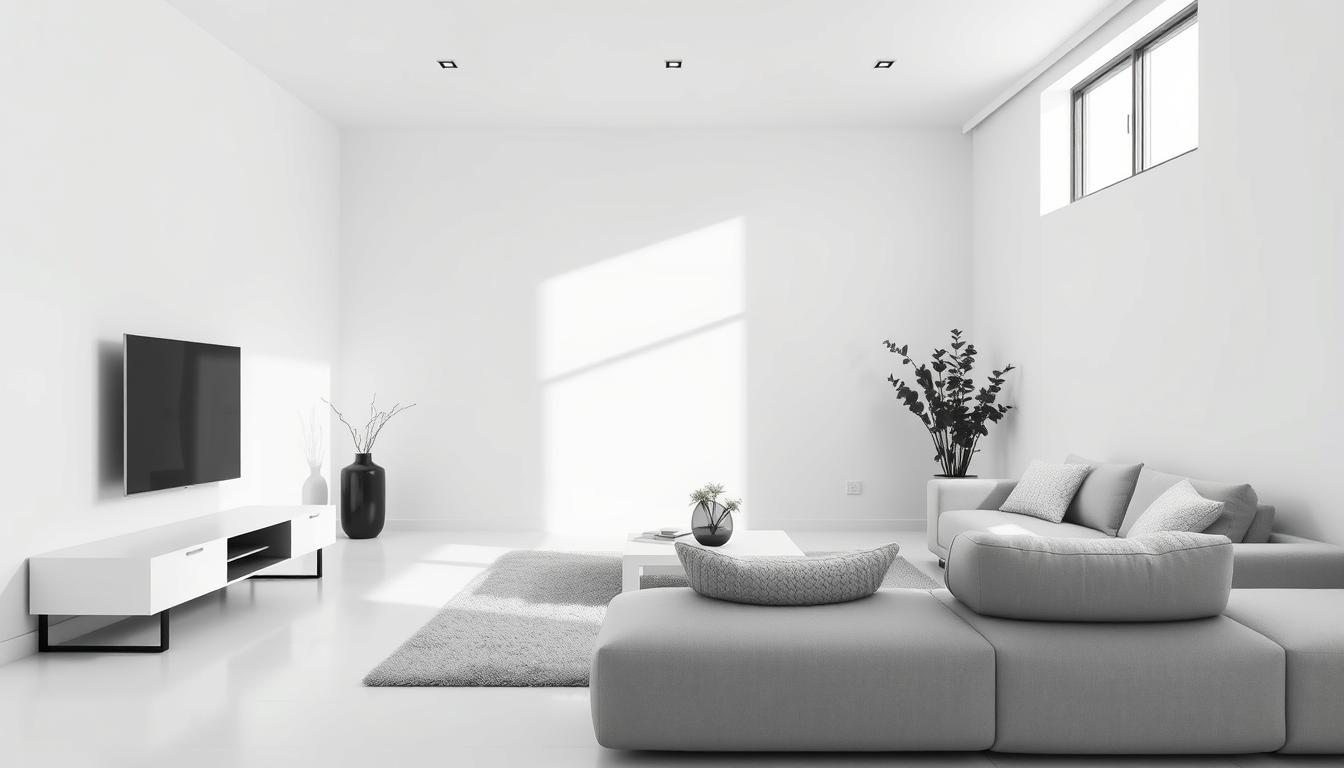With remote work on the rise, having a dedicated workspace at home is key. Studies show a well-designed workspace can increase productivity by up to 20%. In this guide, we’ll show you how to create an efficient interior home office that fits your needs.
We’ll cover everything from the benefits of a home office to tips for making it better. By the end, you’ll know how to design a productive workspace.
Key Takeaways
- Understand the benefits of a dedicated workspace
- Learn how to optimize your space for productivity
- Discover tips for creating a comfortable work environment
- Explore strategies for minimizing distractions
- Find out how to maintain your workspace for continuous improvement
Understanding the Benefits of an Interior Home Office
A dedicated interior home office brings many benefits to your work life. It helps you keep work and personal life separate. This leads to a more organized and productive day.
Increased Productivity
One big plus of having a home office is increased productivity. You avoid distractions and save time on commuting. To boost your productivity, try these workspace ideas:
- Keep your space tidy and organized
- Choose ergonomic furniture for comfort
- Use good lighting to avoid eye strain
By making your home office better, you can work more efficiently. This helps you balance work and personal life better.
Enhanced Focus
An interior home office also helps you enhance focus. Having a specific area for work trains your mind to focus there. This is great for tasks that need deep concentration or creativity. To improve focus, consider:
- Make your workspace quiet and free from distractions
- Use noise-cancelling headphones or background music that helps you concentrate
- Stick to a schedule to keep a regular work routine
By reducing distractions and creating a good work environment, you can focus better. This leads to higher-quality work.
Work-Life Balance
Getting a work-life balance is key to your well-being. An interior home office helps a lot with this. It makes it easier to switch from work to personal time. To keep a good balance, try these:
- Set regular working hours
- Have a space for relaxation and fun
- Set clear boundaries with family and friends during work hours
By following these tips, you can enjoy working from home. You’ll also keep a healthy and balanced life.
Choosing the Right Location for Your Home Office
Setting up a home office means making a key decision: where to put it. The spot you pick can really affect how well you work, how comfy you feel, and the quality of your work.
Evaluating Available Spaces
First, look at the spaces you have at home. Think about each room’s size, layout, and how it can be used for work. Measure the rooms and doorways to make sure your furniture will fit right.
Here’s a simple table to help you check out your options:
| Room | Size (sq. ft.) | Potential Use |
|---|---|---|
| Living Room | 150 | Shared workspace |
| Attic | 80 | Quiet, private office |
| Garage | 200 | Potential for conversion |
Considering Natural Light
Natural light is key for feeling good and working well. Look for spots with lots of natural light. Rooms with big windows or skylights are best because they let in lots of light. This can make you feel happier and work better.
“The importance of natural light in the workplace cannot be overstated. It not only improves mood but also reduces eye strain and enhances overall well-being.”
Proximity to Daily Activities
How close your office is to daily life can be good or bad. Think about how close you want it to be to where you live. If you get distracted easily, a quiet spot might be better.
- Advantages of being close to main living areas:
- Easier to take breaks and chat with family
- Handy for doing household tasks
- Disadvantages:
- Potential for distractions
- Can make it hard to separate work from personal life
By carefully looking at your options, thinking about light, and considering how close it is to daily life, you can pick a spot for your home office. This will help you work better and feel more comfortable.
Essential Furniture for Your Home Office
The right furniture is key to a productive workspace. Choose pieces that are both useful and comfy. This way, you’ll make a space that boosts your work efficiency.
Ergonomic Desks and Chairs
Ergonomic furniture keeps you comfortable and safe from injury. An ergonomic desk lets you work without strain. An ergonomic chair supports your back and legs well.
Experts say a good workspace can make you 20% more productive. Ergonomic furniture is a smart choice for a healthier work area.
A sit-stand desk helps you move and stay alert. Add an ergonomic chair with adjustable height and lumbar support. You’ll have a comfy workspace.
Storage Solutions
Keeping your office tidy is crucial. Clutter distracts and lowers productivity. Use filing cabinets, shelves, and desk organizers to stay organized.
For tips on organizing your home office, check out our guide on designing the perfect home office.
Get a filing cabinet for documents and a shelf for books or decor. Desk organizers keep your space clutter-free, making everything easy to find.
Multi-Functional Furniture
Space is often tight in home offices. Multi-functional furniture is a great solution. For example, a storage ottoman is both a seat and storage. A desk with built-in shelves keeps your area organized.
“The right furniture can transform your home office into a productive haven.”
By picking ergonomic desks and chairs, storage, and multi-functional furniture, you’ll create a space that’s both efficient and comfy. This boosts your productivity and helps balance work and life.
Designing for Comfort and Efficiency
A well-designed home office can greatly improve your work-life balance. A good home office is key for staying productive and comfortable.
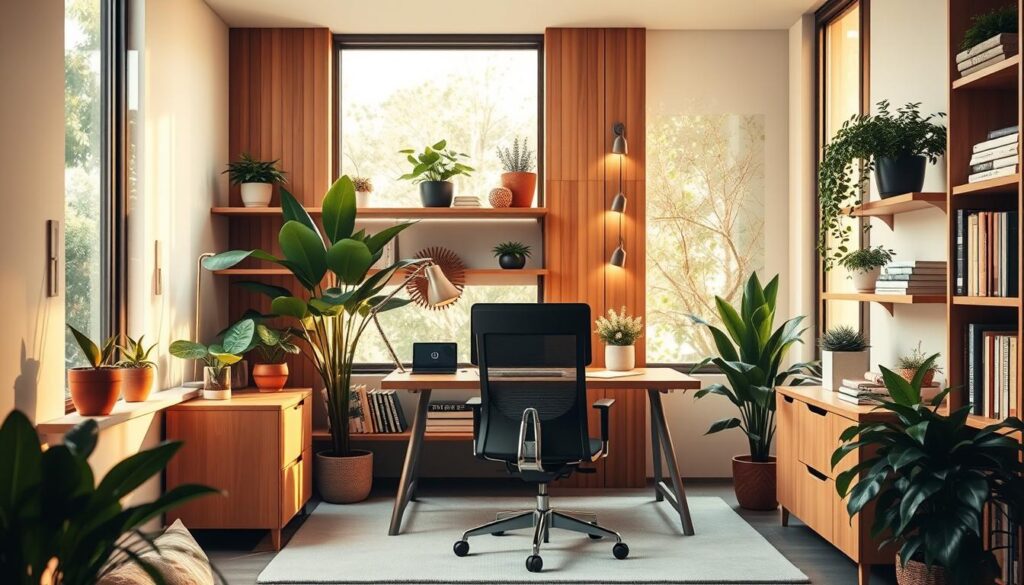
Layout and Flow
The layout of your home office is very important. A well-thought-out layout helps you work smoothly and keeps distractions away. Use the “work triangle” idea to place your desk, chair, and storage for better efficiency.
Begin by measuring your space and planning where you’ll work, store files, and meet with others. Make sure your workspace is ergonomic, with your monitor at eye level and your chair comfy.
Personalizing Your Space
Adding personal touches to your home office can make you happier and more productive. Include things that show your personality, like art, plants, or family photos. “A personal workspace can spark creativity and motivation.”
“The way we design our workspace can significantly impact our productivity and overall well-being.”
Think about adding workspace ideas like a reading area or a standing desk. This keeps your work area fresh and exciting.
Incorporating Technology
In today’s world, adding technology to your home office is a must. Get a reliable computer, fast internet, and a comfy headset for calls.
- Use smart home devices for better lighting and temperature.
- Get noise-cancelling headphones to block out distractions.
- Consider a wireless charging station for your gadgets.
By using technology wisely, you can make your home office design more efficient and effective.
Selecting the Right Color Scheme
A good color scheme can turn your home office into a productive and creative space. It’s key to home office decor. The colors you pick can change your mood, focus, and work experience.
When setting up your home office, knowing how colors affect you is important. We’ll look at color psychology and how to mix calm colors with bold ones.
Color Psychology and Productivity
Colors can change our feelings and how productive we are. For example, blue makes us feel calm and trustworthy, great for a home office. Green boosts creativity and balance. Here’s how different colors can impact your work:
| Color | Effect on Productivity |
|---|---|
| Blue | Promotes calmness and focus |
| Green | Boosts creativity and balance |
| Red | Stimulates energy and urgency |
| Yellow | Enhances happiness and optimism |
Interior design experts say the right color can greatly affect how you feel and work in your home office.
“Color is a power which directly influences the soul.” – Wassily Kandinsky
Creating a Calm Atmosphere
To make your home office calm, use soothing colors like light blue, pale green, or neutral tones. These colors can lower stress and help you relax.
- Choose light, airy colors for walls and furniture to feel open.
- Add natural elements, like plants, for more calm.
- Avoid very bright or bold colors that can be distracting.
Balancing Bold Accents
Even though calm is key, bold accents can add interest and spark creativity. Use bold colors for accent walls, furniture, or decorations.
To mix bold accents well, follow these tips:
- Begin with a neutral color for most of the room.
- Pick one or two bold colors for accents.
- Use the 60-30-10 rule: 60% neutral, 30% secondary color, and 10% bold accent.
By picking the right colors and balancing bold accents, you can make a home office that’s both productive and looks good. It shows the importance of good interior design for office spaces.
Lighting Considerations for Your Office
The right lighting can turn your home office into a productive and creative space. Lighting is key to your work environment. It affects your mood and how well you work.
Natural vs. Artificial Light
Choosing between natural and artificial light is a big decision for your home office. Natural light is good for your mood and energy use. But, it’s not always available, like at night or in small rooms.
Artificial lighting gives you more control and can be adjusted for different tasks. Finding the right mix of both is important for a great work space.
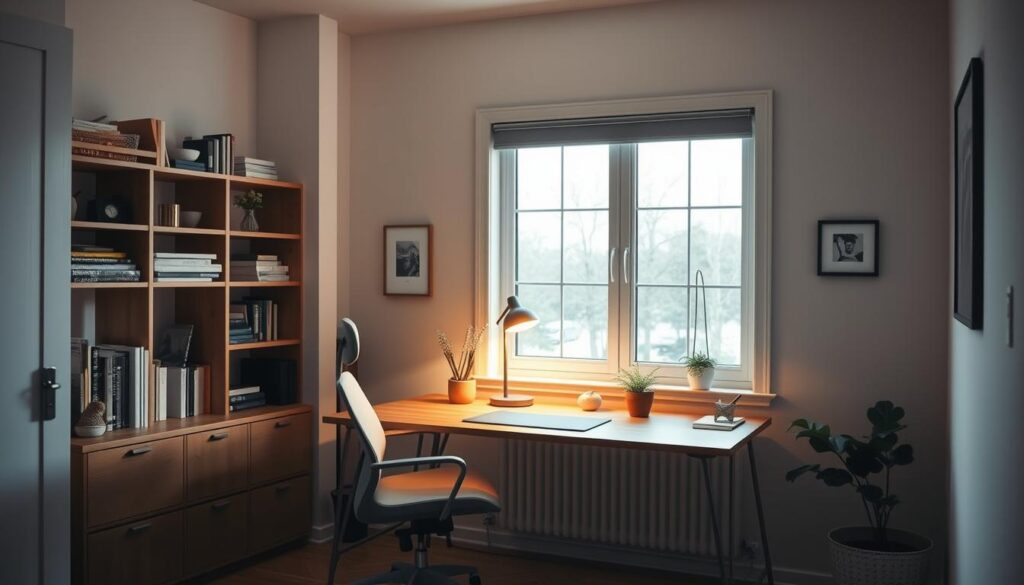
Task Lighting Solutions
Task lighting focuses on specific areas for better work. Desk lamps are great for this, providing direct light where you need it.
Think about your work when picking task lighting. For detailed work, you might need brighter lights. For general office tasks, softer lights are better.
Creating Ambiance
Lighting also shapes the feel of your home office. Ambient lighting sets the mood, making your space feel cozy and inviting.
To get a cozy feel, mix different light sources. Use floor lamps or string lights for a warm, welcoming atmosphere.
| Lighting Type | Purpose | Examples |
|---|---|---|
| Natural Light | General Illumination, Mood Boosting | Windows, Skylights |
| Task Lighting | Focused Illumination for Tasks | Desk Lamps, Under Cabinet Lighting |
| Ambient Lighting | Creating Ambiance, Overall Illumination | Floor Lamps, String Lights |
Organizing Your Workspace
A clean workspace boosts your focus and productivity. An organized home office makes work more efficient and reduces stress. We’ll look at how to declutter, use organizers, and set up a filing system.
Decluttering Strategies
Decluttering is key to an organized space. Begin by removing things you don’t need from your desk and around it. Sort items into three piles: keep, donate, and discard. Be strict about getting rid of items that are no longer useful.
Tips for Effective Decluttering:
- Schedule regular decluttering sessions.
- Use storage solutions to keep items out of sight.
- Consider the 80/20 rule: 80% of the time, you likely use 20% of your belongings.
Using Organizers Effectively
After decluttering, organize what’s left. Use desk trays, file holders, and drawer dividers to keep things tidy. Labeling your organizers makes them even more effective.
Choosing the Right Organizers: Pick organizers that meet your needs and match your home office furniture. For example, a file organizer with many compartments is great for lots of paperwork.
Setting Up a Filing System
A good filing system keeps your workspace clean. Start by sorting documents into types like financial records and client info. Use labeled folders and files, and consider both physical and digital systems.
Best Practices for Filing:
- Keep often-used documents easy to find.
- Store sensitive info safely.
- Update and clean out your files regularly.
Adding Personal Touches and Decor
Turning your home office into a space that shows your style and interests can make it more fun and productive. A well-thought-out home office boosts your motivation and improves your work experience.
Art and Inspirational Quotes
Adding art and inspirational quotes to your home office can really impact your productivity and mood. Pick pieces that speak to you and your work style. For example, a motivational quote above your desk can remind you of your goals every day.
Try mixing framed artwork with unframed prints for visual interest. Adding personal items like family photos or collectibles can also make your space feel more like home.
Plants and Natural Elements
Adding plants and natural elements to your home office can make it calm and refreshing. Plants improve air quality and reduce stress, making them perfect for any workspace.
- Start with low-maintenance plants like succulents or snake plants if you’re new to plant care.
- Use natural elements like wood or stone to add warmth and texture to your decor.
- Try a vase with fresh flowers for a splash of color and a nice scent.
Choosing Accessories Wisely
Accessories can either make or break your home office’s look. Choose items that show your personality and also make your workspace better.
| Accessory | Purpose | Style Tip |
|---|---|---|
| Desk Lamp | Task Lighting | Choose a lamp that complements your desk’s style. |
| Artwork | Personalization | Select pieces that inspire you. |
| Plants | Air Quality | Pick plants that fit your maintenance routine. |
By carefully choosing art, inspirational quotes, plants, and accessories, you can make a home office that’s both useful and reflects your style.
Making Your Office Tech-Savvy
To boost productivity in home office, make your space tech-savvy. A well-equipped office improves work efficiency and experience.
Essential Gadgets and Tools
Choosing the right gadgets and tools is key for an efficient home office. Think about getting:
- a high-performance computer or laptop
- a noise-canceling headset for video calls
- a wireless charging pad for your smartphone
- a state-of-the-art printer with scanning capabilities
These tools streamline your workflow, cut distractions, and boost productivity.
Smart Home Integration
Adding smart home tech to your office can make work better and enhance interior design for office. Install:
- smart lighting systems that adjust with the time
- a smart thermostat for a comfy temperature
- voice-controlled assistants like Amazon Alexa or Google Assistant
These smart features keep you focused and comfortable all day.
Staying Connected
In today’s remote work world, staying in touch with colleagues and clients is crucial. Use:
- video conferencing tools like Zoom or Skype
- project management software for tracking and teamwork
- cloud storage services for easy file access
These technologies help keep communication and teamwork smooth, even from afar.
Maintaining Work-Life Balance in Your Home Office
More people are working from home, making work-life balance a big issue. Home offices offer flexibility and save time on commutes. But, they also make it hard to separate work from personal life.
To manage your home office well, you need strategies for a good work-life balance. We’ll look at setting boundaries, creating a distraction-free zone, and establishing a routine.
Setting Boundaries
It’s key to set clear boundaries when working from home. Choose a specific workspace and set work hours that everyone respects. This helps keep work and personal time separate.
To set good boundaries, consider these steps:
- Choose a specific workspace for work only.
- Set clear work hours and tell your family and friends.
- Keep personal activities out of your workspace.
Creating a Distraction-Free Zone
A distraction-free zone is crucial for productivity. Your home office should be organized to reduce distractions. Turn off personal device notifications and create a quiet, comfy space.
Here are ways to make a distraction-free zone:
- Use noise-cancelling headphones or play calming music.
- Put up a “do not disturb” sign during work hours.
- Keep your workspace tidy to avoid visual distractions.
Establishing a Routine
Having a daily routine helps you stay focused and balance work and personal time. A routine includes regular work hours, breaks, and time for exercise or relaxation.
A good routine might look like this:
| Time | Activity |
|---|---|
| 8:00 AM – 9:00 AM | Morning routine (exercise, breakfast) |
| 9:00 AM – 12:00 PM | Work |
| 12:00 PM – 1:00 PM | Lunch break |
| 1:00 PM – 5:00 PM | Work |
| 5:00 PM – 6:00 PM | Relaxation/Leisure |
By using these strategies, you can keep a healthy work-life balance in your home office. Be intentional with your space and time. This way, work and personal life can complement each other.
Tips for Continuous Improvement
Keeping a productive home office takes ongoing effort. As we work from home, it’s key to regularly check and improve our workspace. This ensures it stays efficient and comfy.
Regular Assessments
Getting feedback from family or colleagues can offer great insights. We can ask for ideas on how to make our home office better. This can boost our productivity.
Adapting to Change
Changing our home office furniture and layout helps us stay focused. Think about using furniture that does more than one thing. This can help avoid distractions.
Staying Motivated
To stay inspired, we can add personal touches like artwork or plants. This makes our space reflect our personality and work style. It can really help us work better.
By using these tips, we can make our home office both useful and comfy. This lets us do our best work.

